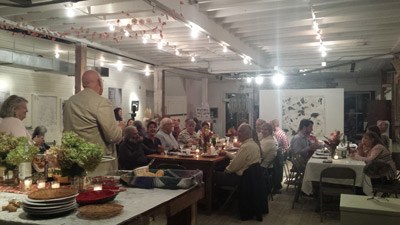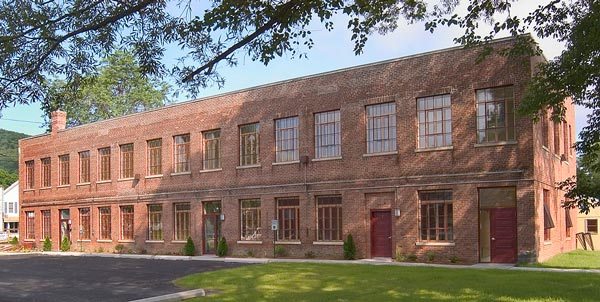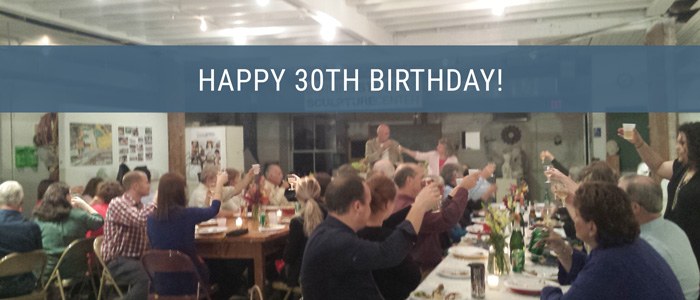NeighborWorks of Western Vermont is celebrating 30 years of supporting sustainable homeownership and resilient communities!
Happy 30th Birthday NeighborWorks!
Past and present board members and staff got together at the West Rutland carving studio on Thursday night to celebrate the 30th anniversary of NeighborWorks of Western Vermont.
 Joel Pliner and Ron Bower were honored for their many years of service on the staff and board (respectively) of NeighborWorks of Western Vermont.
Joel Pliner and Ron Bower were honored for their many years of service on the staff and board (respectively) of NeighborWorks of Western Vermont.
Joel retired in August, the last of NeighborWorks of Western Vermont’s original team from 1986. Joel played a crucial role in the founding of Rutland West Neighborhood Housing Services, d/b/a NeighborWorks of Western Vermont.
On Joel’s last day in the office, we enjoyed a barbeque and he delighted us with stories from NWWVT’s beginnings.
Four Neighborhoods
In the early 1980s, community members from small neighborhoods in West Rutland, Fair Haven, Castleton, and Rutland got together to discuss a new congressional initiative called the “Neighborhood Reinvestment Corporation” and the Neighborhood Housing Services organizations that were springing up across the country.
Three of them took the lead and contacted Neighborhood Housing Services (NHS). They were informed they’d need to form a consortium to qualify for the grant to form a local NHS- so they did, and they were funded.[/et_pb_text][et_pb_video src=”https://youtu.be/-OqbJ4w_d6g” _builder_version=”4.2.1″ hover_enabled=”0″][/et_pb_video][et_pb_text _builder_version=”4.2.1″ hover_enabled=”0″]Rutland West was founded in 1986 with five staff members. Together they worked to apply the NHS model, developed for urban settings, to their small Vermont neighborhoods. Each neighborhood, the triangle section of West Rutland Marble Street, southwest side of Fair Haven, the Hydeville strip in Castleton, and Northwest Rutland had a committee headed by a Rutland West staff member.
The office was located on the second floor of the West Rutland town hall, complete with Radio Shack TRS 80 Computers with 5 ¼ floppy disks and a Daisy Wheel printer (essentially a type writer connected to the computer). Joel claims, “it was like rattling off a machine gun!”
All of the books and project ledgers were kept by hand.[/et_pb_text][et_pb_video src=”https://youtu.be/aC8hgQQg2bg” _builder_version=”4.2.1″ hover_enabled=”0″][/et_pb_video][et_pb_text _builder_version=”4.2.1″ hover_enabled=”0″]From the original grant, it was strictly a housing rehabilitation program, funded through Vermont Community Development Program and Neighborhood Reinvestment Corporation (now NeighborWorks America). Every two years Rutland West would reapply.
“If we didn’t get approved by VCDP one year,” says Joel, “that would’ve been the end of the program.”
Housing rehab projects included typical repairs like porches, roofs, and foundations, but sometimes involved installing the first plumbing system in homes or wading through waist-deep flood water in flea ridden basements.
Town Recruiting
Eventually, Rutland West outgrew its first four neighborhoods and started to recruit entire towns.
“What we used to do was recruit a new town like Proctor,” says Joel, “and make an agreement with them that they would get the bulk of the money on the new VCDP grant but that the proceeds of the loans would go back into the revolving loan fund and they would continue to be eligible for help and we just kept adding towns like that.”
The process was slow, but slowly Rutland West grew its coverage from a few neighborhoods to a few towns to all of Rutland County, and then Bennington and Addison counties as well.
Tight Quarters in the Town Hall
[/et_pb_text][et_pb_video src=”https://youtu.be/xqDc3X9Cmsk” _builder_version=”4.2.1″ hover_enabled=”0″][/et_pb_video][et_pb_text _builder_version=”4.2.1″ hover_enabled=”0″]“In 2001,” recalls Joel, “We were just moving into the church which was then a post office. It was 1100 square feet and we had 11 people. The great thing about that was that Jackie would see me looking around for something and she’d say: here!”
“Then Ludy came and she had vision,” adds Jackie.
110 Marble Street
Right in the back of 110 Marble Street, before it was renovated by NeighborWorks of Western Vermont, a small antiques dealer discovered ebay.com, back when it had four employees. He found the website clunky, and sent them an email with his suggestions- and received a job. For years the operation grew, and EBAY license plates popped up all over West Rutland.[/et_pb_text][et_pb_video src=”https://youtu.be/s1_ypZfeEio” _builder_version=”4.2.1″ hover_enabled=”0″][/et_pb_video][et_pb_text _builder_version=”4.2.1″ hover_enabled=”0″]
The Renovation

“The thing of this building was- it was that far from being bulldozed,” says Ludy, holding her fingers an inch apart. “If we hadn’t sunk in three times the value it could’ve never been restored. We bought it for $85,000 and we put $4 Million into it with all the grants and so forth, creating 6 apartments and community space and offices.”
It was worth it. Fully renovated and redesigned by future NeighborWorks employees Gregg Over and Melanie Paskevich, the Kazon Dress Factory became a safe, efficient, and healthy (not to mention beautiful) face lift for Marble Street. In 2004, NeighborWorks of Western Vermont moved into their new building, and from there, it’s all history.

